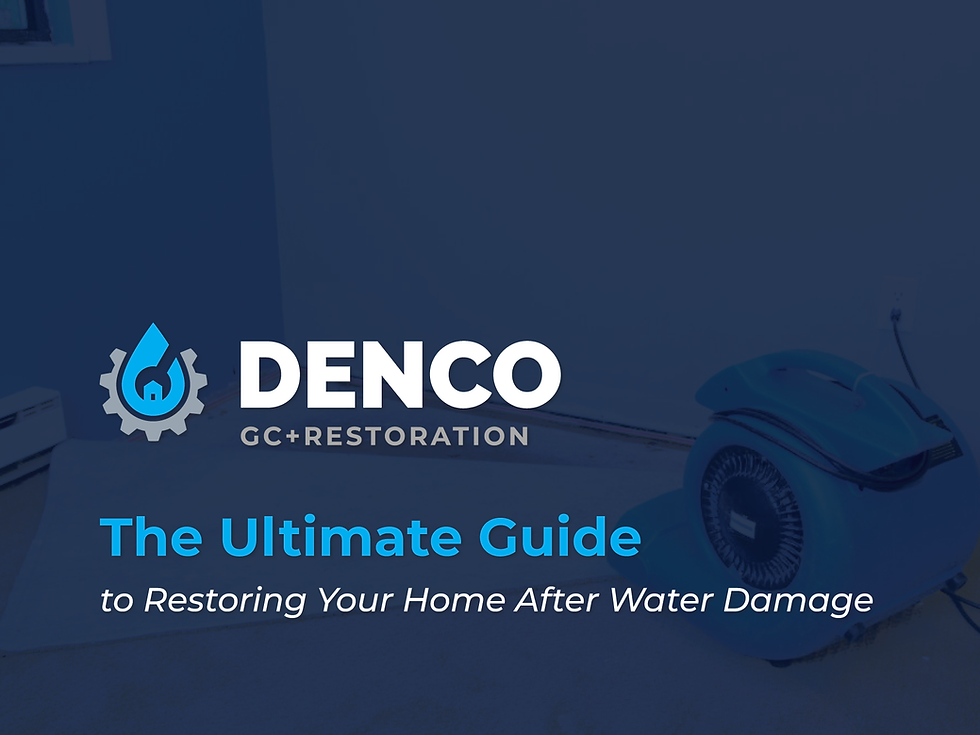The Ultimate Guide to Restoring Your Home After Water Damage
- dencocontractingin
- Jul 3, 2025
- 4 min read

Water damage is one of the most stressful and costly issues a homeowner can face. Whether it’s the result of a burst pipe, heavy rain, a leaking roof, or an appliance failure, water damage can quickly escalate, threatening not only your home’s structure but also your health. In this ultimate guide, we’ll walk you through everything you need to know about identifying, addressing, and restoring your home after water damage so you can act fast and protect your investment.
Common Causes of Water Damage
Knowing what causes water damage is key to prevention. Plumbing issues such as burst pipes, slow leaks, or backed-up drains can result in sudden or prolonged exposure to moisture. Weather events are another major contributor, especially in regions prone to heavy rains, flash floods, and snowmelt. Appliance failures, like those from washing machines, dishwashers, or water heaters, can release large amounts of water without warning. Roof leaks caused by damaged shingles, poor flashing, or clogged gutters allow water to seep into ceilings and walls. Foundation cracks can also let water into basements and crawlspaces, particularly during periods of intense moisture or when landscaping doesn’t divert water properly.
What to Do Immediately After Water Damage
When water damage happens, acting quickly is crucial. In the first 24 hours, your priority should be safety. If there’s standing water, turn off your electricity to avoid any risk of electric shock. Try to stop the source—whether that means shutting off a valve or patching a leak temporarily. Take photos and videos of the damage for insurance documentation. Then, notify your insurance company to begin the claims process. Most importantly, call a professional restoration contractor. The sooner they arrive, the more damage can be mitigated before it spreads.
Understanding the Categories of Water Damage
The type of water that caused the damage also affects how you handle the cleanup.
Category 1 water is clean, like water from a burst pipe or rain. It’s safe if addressed quickly.
Category 2, or grey water, may contain contaminants—such as water from appliances like washing machines or dishwashers.
Category 3 is black water, which includes sewage or floodwater and is dangerous due to bacteria and toxins.
Categories 2 and 3 require professional equipment and procedures to clean and sanitize affected areas.
The Water Damage Restoration Process
Once a professional arrives, the water damage restoration process begins. It typically starts with a full inspection and assessment to determine the extent of the damage. Using tools like moisture meters and thermal imaging, the team will locate hidden pockets of moisture. Then comes the water removal and extraction phase, where standing water is pumped out and absorbent materials are addressed.
Next is drying and dehumidification. This step uses high-powered fans and industrial dehumidifiers to dry the structure thoroughly. Once everything is dry, it’s time for cleaning and sanitizing. This ensures there’s no mold or bacteria left behind. Any porous materials, like drywall or insulation, that can’t be properly cleaned will be removed.
Finally, repairs and restoration can begin. This may include replacing damaged drywall, refinishing flooring, painting, and reinstalling fixtures. Often, this step is where you can also improve upon your previous setup by upgrading outdated finishes.
The Hidden Danger of Mold
It’s vital to address water damage quickly because of mold. Mold can begin growing within 24 to 48 hours of moisture exposure. It thrives in damp, dark environments like behind walls and under flooring. Not only can mold lead to costly repairs, but it also poses serious health risks—especially for individuals with allergies, asthma, or compromised immune systems.
Mold remediation involves removing contaminated materials and treating surfaces with antimicrobial solutions to ensure a safe environment.
Restoration as an Opportunity for Remodeling
Restoring your home after water damage often means remodeling. This is an opportunity to replace not just what was damaged, but to update outdated features and improve your living space. Installing new flooring, updating your kitchen or bathroom, and repainting walls can all increase your home's value. At the same time, you’ll be restoring it to a safer, more functional condition.
Preventing Future Water Damage
Preventing future water damage should be part of your restoration strategy. Install water leak detectors near high-risk areas like sinks, water heaters, and appliances. Maintain your roof and clean your gutters regularly to prevent clogs that can lead to leaks. Insulate exposed pipes to avoid freezing in the winter, and inspect your appliances for signs of wear. Make sure your landscaping slopes away from your home’s foundation to direct water away rather than toward your basement.
Why Professional Help Matters
While DIY fixes may seem tempting, professional help is essential in many cases. Licensed contractors have the tools and expertise to properly assess water damage, perform safe mold remediation, and complete structural repairs to code. They also help manage insurance claims and ensure that nothing gets missed during the restoration process.
Trust the Experts at Denco Contracting & Restoration
At Denco Contracting & Restoration, we specialize in turning disasters into peace of mind. As a family-owned Colorado business, we understand the unique challenges of our region’s weather and construction. We’re committed to providing fast, reliable service and quality craftsmanship so you can feel confident in your home again.
The longer water damage goes unchecked, the worse it becomes. Acting fast, calling the right professionals, and knowing what to look for can mean the difference between a simple fix and a costly, complex repair. When the unexpected happens, trust a team that brings not just expertise—but care.
#WaterDamageRestoration #HomeRestoration #ColoradoContractor #MoldMitigation #FloodRecovery #DencoContracting #ProtectYourHome #RemodelWithPurpose #AsbestosAbatement
We are always ready to help.
Need help now? Contact Denco Contracting & Restoration for a FREE assessment and peace of mind.




Comments